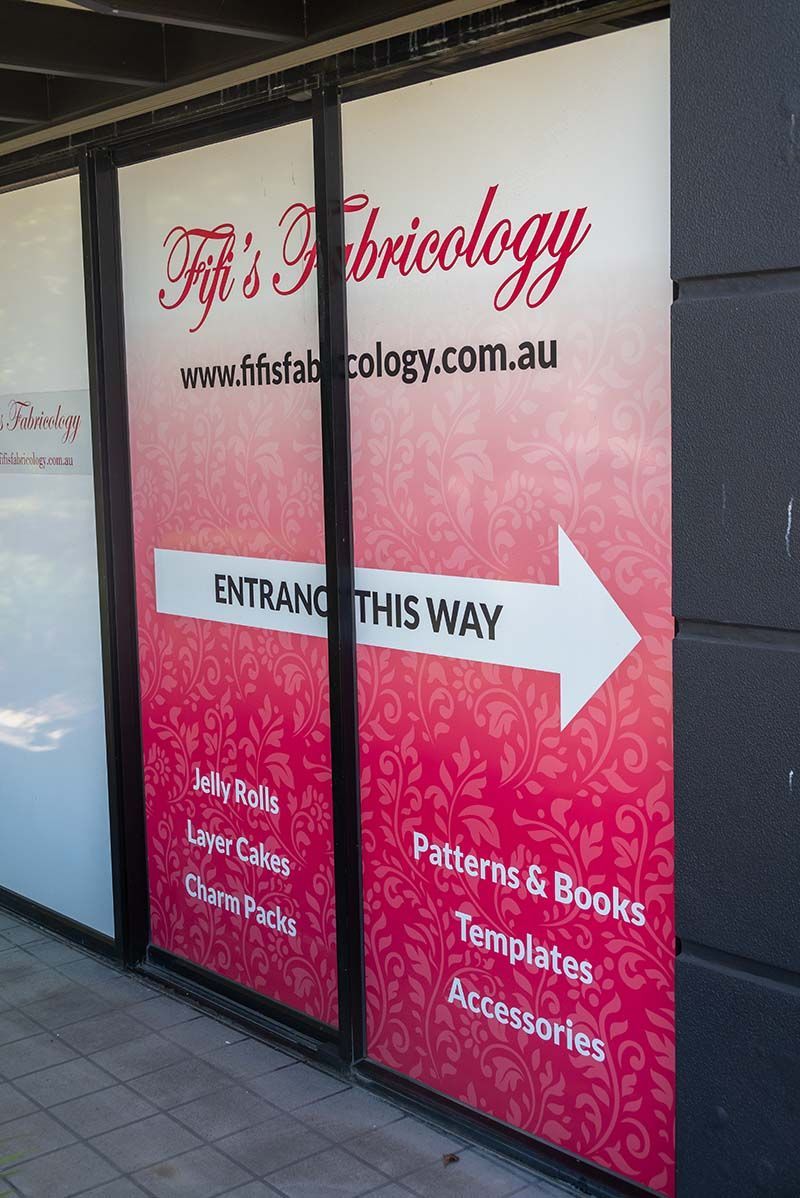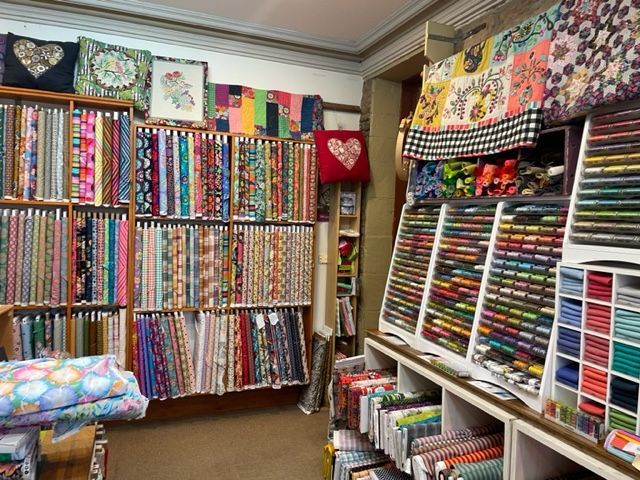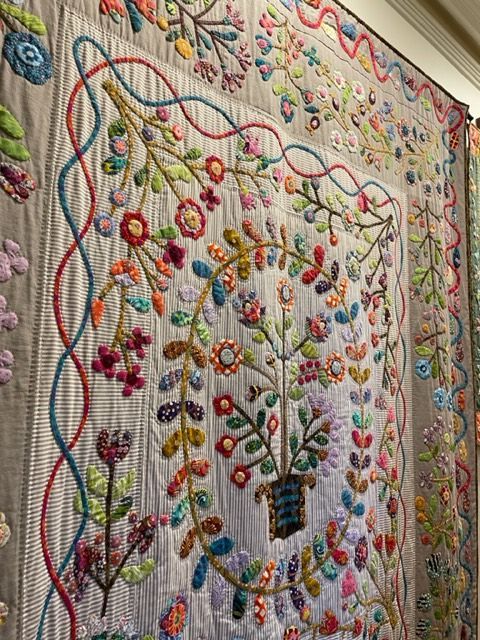In the US the influence of Australian designers has become much stronger during the last 15 years and designers like Jen Kingwell, Kathy Doughty, Wendy Williams, Karen Somerset, Irene Blanck (and many more) have become well known names. Of course, these designers are not all in the same style, but they have given us a fresh approach in their styles. No other country has so many designers doing so well in the US. For them, the US market is a nice expansion of their market with no language barrier on either side. Their work was new and for a while Australian patterns were the hottest trend. Jen Kingwell's patterns especially, even though they are far from easy. When her breakthrough Gypsy Wife - these days, the pattern is called Wanderer's wife - came out in the US, it was the first pattern that had blocks of different sizes that came together as a puzzle. Instead of making 12 or more of the same blocks, her quilt came together by sewing blocks together in sections. That was new and super creative and I think this pattern should be on every quilter's "to do" list, just because it is so eye opening. She had partial seams, that was new (again). Irene Blanck had a new style in applique, Karen Somerset brought new life to reproduction style medallion quilts. However, it was most of all the use of colors that stood out. Australian designers have a special way of combining colors and designs: it is more jubilant, more free and the combination of busier prints and colors made them stand out. They use big flowers with more ease and there seems to be a real preference for more scrappy quilts. They are not really scrappy, they are "planned" scrappy. To Australian designers it comes easier to combine prints and really mix them. Plaids with flowers, checks with dots....abundance. More fabrics! I will write another blog about this soon.
This abundance of colors is not only happening in quilting. It's everywhere in the Australian culture: clothing, packaging, cell phone cases... all so cheery in that bright and sunny daylight that draws people to beaches everywhere. Life is good in Australia!
New Zealand had a little bit less color. The country is so focused on preserving its pristine and absolute stunning landscape. For instance: there are no (or very, very few) public trashcans. You are supposed to take your trash "rubbish" with you and can't expect others to clean it up for you. It's amazing what that policy does. You are much more aware of your empty plastic bottles, your food wraps... The country is so clean, also in the bigger cities! The hotel room waste basket has a divide so items that can be recycled are already separated at the source.
We had the impression that Covid had been really hard on New Zealanders and many shared with us their struggle. The country is so dependent on tourism and with the borders closed for so long, people have had a hard time. Many are leaving or thinking about leaving for Australia and they shared that with us..... So often they thanked us for coming and they were eager to show their beautiful Maori culture with us. "Please do take pictures, any questions?" It was so nice. At the same time the Aboriginal places in Australia had signs everywhere that we were not allowed to take any pictures. "Out of respect". The beauty of travel is that you learn about different values and respect can have different faces. We did and we did not take pictures.
Back to fabric: Knowing the American quilting world, I was eager to see the Australian one. In Australia, I saw many American fabrics. Whatever is popular here, is also popular in Australia. Kaffe Fassett, Anna Maria Horner, Tilda, Grunge was in every quilt shop. Patterns from Elizabeth Hartman, Alison Glass, Jaybird. Mainstream USA is also mainstream Australia. Quilt shops are closing in Australia (and NZ) as well. Every shop told me that they had less neighbors than a few years ago. Many new pattern designers are no longer in shops, a trend we see in the US just us much. I can find more Australian patterns online than in shops and that was quite frankly a little bit disappointing. I had hoped to find lots of new things!
Australia and New Zealand have a big department store, Spotlight, with an impressive selection of fabrics. Every city has a Spotlight and that means that sewing and quilting are thriving. Spotlight is what JoAnn's is in the US and those kind of stores are important as they introduce many people to sewing and quilting. Sooner or later some of those customers, will discover independent quilt shops. For instance, in Europe, you don't have this or the fabric area is much, much smaller.
The price of fabric is anywhere between 25-33 Australian dollars per meter (1 meter is a little bit more that a yard), which is between 18-23 American dollars. About 35% more expensive, just like in Europe. While fabric is much more expensive in Australia, many other items (groceries, transportation) are less costly. I really don't know why this is the case. Just counting our blessings when we buy fabric! Do you know when I was still doing shows with an international attendance (Houston, Quiltcon), that I could see in the speed of the hand that was touching the fabrics, if it was an American hand or a hand from another country? So funny! Foreigners didn't have to think so hard about a fabric, it was such a bargain! They more or less grabbed what they could and for that price they would figure it out at home...I thought of this as I was touching the fabrics in Australia. I bought just a few, more for my memory than for projects. Fat quarters at $7-8 slow you down!
I had a conversation with John Doughty, the husband of Kathy Doughty, who looked at me when I entered the shop in a suburb of Sydney. "Don't I know you from Houston??" So funny, yes you do! I always bought all the patterns Material Obsession had left at the end of the show. This way they didn't have to pay for freight back to Australia and I got patterns without shipping cost.
I asked John why even the Australian fabrics, the aboriginal fabrics, were so expensive in Australia. M&S Textiles is located in Melbourne. I can get that fabric in the US for $12.00 and it would have cost about $22 in Australia. Isn't that strange? His answer? "We have no Australian fabric any longer. All fabrics are made in Korea, just like the American designed fabrics. So the design may be Australian, the manufacturing is Asian. It cost just the same".
Where is a fabric from when the designer lives in country A, the printing is happening in country B and the fabric is being distributed by a company in country C? Jen Kingwell is Australian. Her fabric is getting printed in Korea for Moda in Dallas, TX. Australian Kathy Doughty designs for American Figo fabrics, P&B (and others) has some South American designers who send their design files electronically to the creative director in the US. Petra Prins is Dutch, but her Dutch Heritage fabrics are not printed in Holland. It seems the question "where is a fabric from? ", has no simple answer. Very few fabrics are truly 100% made in one country. The quilting industry has become a global industry and my visit to Down Under made that perfectly clear.




